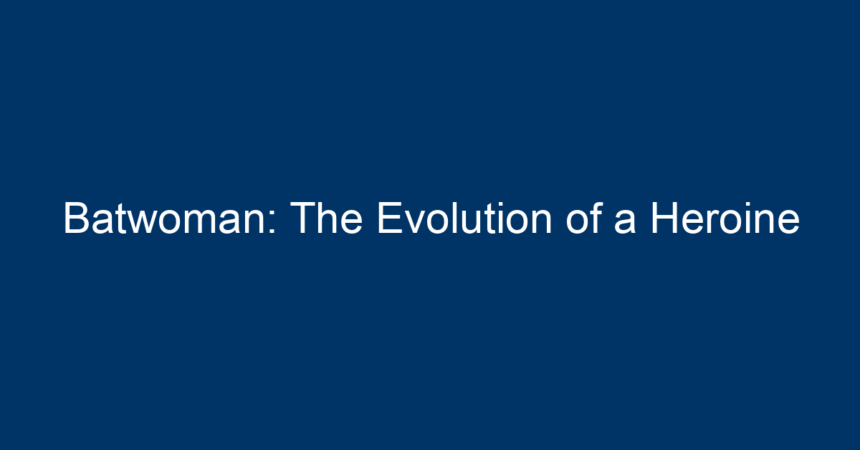Introduction
In the realm of comic books, few characters have experienced as dynamic an evolution as Batwoman. Emerging from the shadows of Gotham City, she has transformed from a lesser-known figure into a powerful symbol of resilience, identity, and heroism. In this article, we will delve into the rich history of Batwoman, exploring her origins, development, and the impact she has had on both the comic book universe and popular culture.
The Origins of Batwoman
Batwoman, originally known as Kathy Kane, first burst onto the scene in Detective Comics #233 in 1956. Created by writer Edmond Hamilton and artist Sheldon Moldoff, she was introduced as a love interest for Batman, a character who had previously operated in a largely male-dominated universe. Kathy Kane was a wealthy socialite and expert in various martial arts, embodying the spirit of a modern-day heroine.
Over the years, Batwoman became a character who not only fought alongside Batman but also carved her own path. Her background as a former performer—often referred to as an agent of justice—allowed her to embody both glamour and grit. However, her initial adventures fell into obscurity in the 1960s and 1970s as comic book sensibilities shifted.
A New Beginning: The 21st Century Rebirth
Batwoman’s significant transformation began in the early 2000s when writer Greg Rucka and artist J.H. Williams III revitalized her character. The introduction of a new Batwoman, Kate Kane, marked a turning point in her narrative. Kate, a strong and complex character, emerged as the first openly lesbian superhero in mainstream comics. This bold move not only diversified the superhero landscape but also resonated deeply with readers looking for representation.
In the critically acclaimed 52 series, Rucka explores Kate’s backstory, revealing her military pedigree, trauma, and struggles with her sexual identity. Unlike many previous iterations of female superheroes who often existed in the shadows of their male counterparts, Kate Kane stands proud, showcasing her unique voice and mission.
Batwoman’s Signature Style and Symbolism
Batwoman’s look is iconic—her sleek, form-fitting suit, complete with a bold red wig, has become a symbol of her independence and strength. Unlike traditional takes on female heroes, who often sport revealing outfits, Kate’s costume reflects both practicality and personality. The dark aesthetics of her costume, coupled with her striking emblem, present a formidable presence in Gotham.
This attention to design is not just cosmetic; it tells a deeper story. The suit signifies her rejection of victimhood and her command over her narrative. Batwoman is not merely a sidekick or romantic interest; she is an independent force to be reckoned with.
Thematic Depth: Exploring Identity and Trauma
One of the defining features of Batwoman’s character is her exploration of identity and trauma. Kate Kane’s journey is not just about fighting crime but also facing personal demons. Her backstory is laced with elements of grief, loss, and the struggle for self-acceptance, which allows readers to connect with her on a more emotional level.
In the Elegy storyline, writer Greg Rucka and artist J.H. Williams III tackle themes of loss and revenge, illustrating how Kate’s past shapes her present. The emotional depth of her character provides a stark contrast to the often black-and-white morality found in superhero narratives. Through her conflicts, we see that heroism is not a singular path but a multifaceted journey, fraught with challenges and difficult choices.
Batwoman in Television and Pop Culture
Batwoman’s reach extends far beyond the pages of comic books. In 2019, the character made a significant leap to television in the series titled Batwoman, showcasing her adventures on The CW network. Portrayed by Ruby Rose in the first season, and later by Javicia Leslie, the series explores themes of legacy, justice, and empowerment. The show brought Batwoman into mainstream media, introducing her to a new audience.
The representation of an LGBTQ+ character as the lead of a superhero series sparked conversations around inclusion and diversity in Hollywood. The series not only succeeded in bringing Batwoman to new heights but also fostered discussions about identity, family, and the fight for justice—core themes that have always defined the character.
The Impact of Batwoman on Feminism and Representation
Batwoman stands as a beacon of feminist representation within the comic book genre. Her character challenges traditional gender roles and expectations, paving the way for future female heroes. The evolution of Batwoman signals a significant shift in how heroines are portrayed—no longer bound by stereotypes, they can express strength, vulnerability, and independence in equal measure.
As the first major openly LGBTQ+ superhero in the DC universe, Batwoman has also amplified the conversation around representation in media. Her stories resonate with those who see their own struggles mirrored in her character, demonstrating that heroes come in many forms.
The Future of Batwoman: What Lies Ahead?
As we look toward the future, the trajectory of Batwoman seems brighter than ever. With ongoing comic book series and potential new television adaptations in various stages of development, her character continues to evolve. The introduction of nuanced storylines that embrace diverse identities showcases the ongoing importance of representation in modern storytelling.
Moreover, the comic book industry has seen a notable increase in female writers and creators who are eager to shape the stories of iconic characters like Batwoman. This shift bodes well for the development of complex, authentic narratives that speak to a broader audience.
Conclusion: Embracing the Batwoman Legacy
Batwoman embodies more than just a heroic persona; she represents a revolution in comic book storytelling. Her journey from obscurity to empowerment serves as a reminder of the importance of representation and diversity within the superhero genre. As readers and viewers, we can take actionable insights from her story: the power of resilience, the necessity of embracing one’s identity, and the strength that lies in facing adversity.
In celebrating Batwoman, we celebrate progress and the ongoing evolution of female heroes in comics and beyond. As we continue to engage with such stories, we contribute to a richer, more inclusive narrative for future generations, enabling heroes like Batwoman to inspire many more to take up the mantle of bravery, authenticity, and justice.




